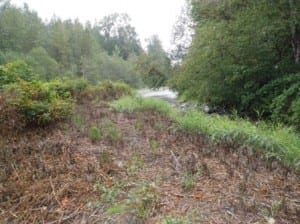 A partnership between the Stilly-Snohomish Fisheries Enhancement Task Force and Seattle City Light is making life a little easier for salmon in the Tolt River near Carnation by removing invasive, non-native plants and replacing them with native species.
A partnership between the Stilly-Snohomish Fisheries Enhancement Task Force and Seattle City Light is making life a little easier for salmon in the Tolt River near Carnation by removing invasive, non-native plants and replacing them with native species.
A partnership between the Stilly-Snohomish Fisheries Enhancement Task Force and Seattle City Light is making life a little easier for salmon in the Tolt River near Carnation by removing invasive, non-native plants and replacing them with native species.
“You can see the difference we are making,” said Denise Krownbell, a senior environmental analyst for City Light. “Dense thickets of invasive weeds have been cleared. As native plants return, they will enhance the habitat for young salmon.”

Invasive weeds were treated three times at this site along the Tolt River in 2010. The site used to be covered in a dense thicket of invasive Himalayan blackberry.
Invasive weeds hurt stream habitat by transforming streamside vegetation from multi-species communities to dense patches of single-species invasive weeds. This also can change stream conditions, such as raising water temperature, increasing erosion and decreasing vegetative contributions to the stream food web. All these conditions affect spawning and rearing habitat for salmon.
The task force is partnering with Seattle City Light on a three-year weed control and riparian planting project on City Light property with funding from the Salmon Recovery Funding Board.
Last year, crews targeted non-native species, including butterfly bush, Himalayan blackberry and Scotch broom, on about three acres near Carnation, using spring weed removals and herbicide treatments in July and September.
For 2011, the Task Force will monitor the re-growth of the invasive weeds and apply herbicide treatments as necessary. When response to the treatments is satisfactory, crews will plant native species.
Native plants are adapted to the area and generally thrive. Diverse, native plant cover along riverbanks provides shade to the water, keeping it cool. It provides cover for juvenile salmon in the river so they can avoid predators. And it supports a host of wildlife and insects along the river, some of which become food for larger land animals or fall into the river and become food for fish.
Seattle City Light gets almost 90 percent of its electricity from hydroelectric dams, including those it operates on the Tolt, Skagit and Pend Oreille Rivers.
“We recognize that we share the rivers that power our dams with important fish and wildlife,” Superintendent Jorge Carrasco said. “That’s why we are committed to operating in an environmentally sensitive manner. Helping to restore salmon habitat and native plants is just one of the many ways we are living up to that stewardship commitment.”
Seattle City Light is the 10th largest public electric utility in the United States. It has some of the lowest cost customer rates of any urban utility, providing reliable, renewable and environmentally responsible power to nearly 1 million Seattle area residents. City Light has been greenhouse gas neutral since 2005, the first electric utility in the nation to achieve that distinction.